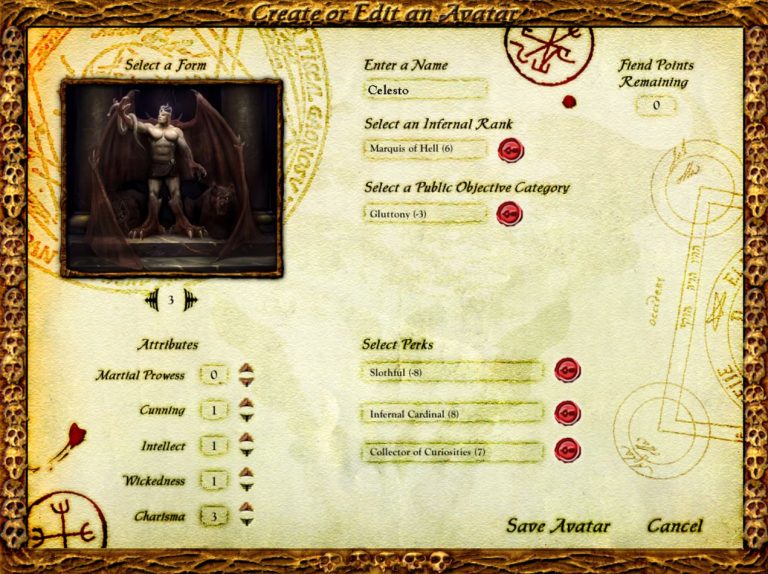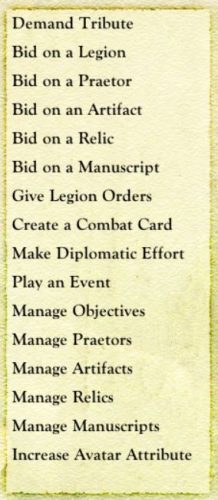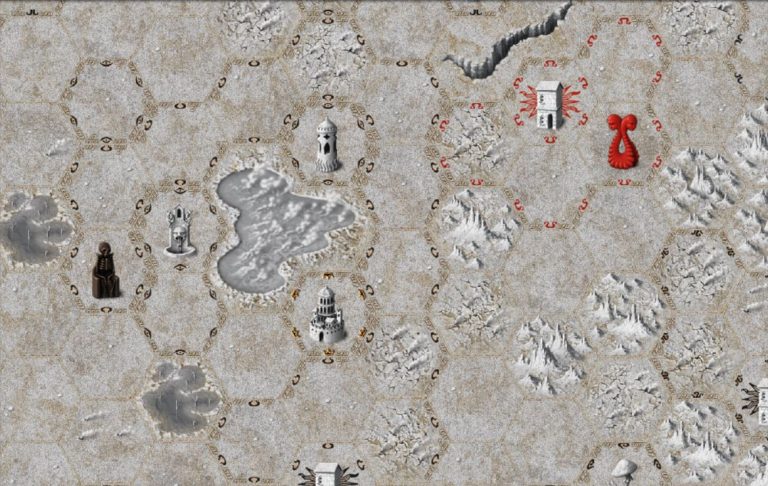To Reign in Hell: Solium Infernum Review

By MARK WILSON

Year Published: 2009
Players: 1-6
To Reign Is Worth Ambition
Solium Infernum (SI) is a play-by-email indie video game that came out in 2009. I’m not in the habit of covering video games in my blog, but I make an exception for two reasons:
- SI plays like an elaborate, epic board game, or even a tactical roleplaying game, not like most video games you’re used to.
- It’s damned good.
The game’s title translates to “The Seat of Hell,” and it’s both an appropriate description and deliciously evocative. It’s a turn-based area control strategy game played on a hex map of Hell. Lucifer has abdicated and his throne sits empty. You and a handful of other ne’er-do-wells have staked a claim, and must prove your worth to the Infernal Conclave/Council, who are determining Hell’s next ruler.
If it sounds like a hotbed for sinister negotiations, you’re right.
The game allows for solo play against AI opponents or play-by-email multiplayer in a system that will seem arcane to many modern gamers, but has certain advantages that other formats lack.
The game’s designer quite clearly had a vision: to bring to life the backroom dealings, backstabbing and treachery, lies and half-truths that would take place when Hell’s most powerful demons started butting heads, with the throne of Hell at stake. To a large extent, I think he succeeded. The game is not without flaws and age spots, but it’s a remarkably unique vision.
Solium Infernum – Mechanics
I won’t go into a ton of detail, because it’s actually a rather complicated game. Fortunately, most of the complication is in the probabilistic math that governs everything from combat and rituals (i.e. spellcasting), to capricious events that always seem to punch someone in the gut. While you could go mad trying to figure it all out, the basics are logical enough and the game handles the more fiddly math behind the scenes.
In practice, you have an Avatar (archfiend) with certain stats and abilities, and begin with two orders per round. These orders will routinely involve demanding tribute from your minions (which provide you resources, which power all sorts of other actions), purchasing ground forces, purchasing individual gladiatorial combatants (Praetors) and mystical artifacts from the game’s communal Bazaar (artifacts and relics), moving your troops, and making demands of your fellow archfiends. As the game progresses, you’ll usually acquire more orders per turn, more powerful forces, and more oblique powers through your rituals and/or relics.
The way you war with other archfiends is appropriate and amusing. You can’t just walk into their territory. Hell has manners and rules. You need a legitimate vendetta that is approved by the Council before you can go to war, so you have to manufacture drama in the form of making demands, sending gifts and hurling insults at your opponents (or responding to their demands, gifts and insults). The vendettas then have specific rules governing them; what you must do, in how much time, to be successful. These temporary skirmishes dominate much of the middle game.
Combat between your forces (legions) is an elaborate rock/paper/scissors game, with legions having three different stats for combat. There are tons of ways to manipulate this interplay, and also small amounts of random chance thrown in that can confer minor stat bonuses for one side or another (to simulate luck). Gladiatorial combatants (Praetors) feature a similar system, but also add special abilities into the equation. The resulting number of possibilities is occasionally overwhelming.
This is all to acquire Prestige, the game’s victory points. Holding places of importance grants prestige. Winning ground battles grants prestige. A successful vendetta grants prestige. Gladiatorial success grants prestige. Simply hurling an insult can give you prestige if the recipient simply accepts it without rebuttal. But the reverse is true in all cases, so all of these provide an intense tug of war for prestige, with multiple ways to improve your chances in any of them. The game ends via probabilistic math again, when the Conclave pulls its 15th voting token. As the tokens are pulled, the chance the next will be pulled increases slightly. In practice, endgame in a normal-length game usually occurs around turn 50-55.
So what happens when there’s a runaway prestige leader, which will happen in many games?
The second way to win the game is by taking and holding Pandemonium, the game’s capital. It’s a really tough nut to crack, though, and as soon as you take it, the Council turns on you and you’re fair game for every other player, with or without a vendetta. So you have to defend yourself, holding Pandemonium for five turns, while surviving an onslaught. But it’s possible, which means there’s always a fighting chance to come back from the dead, so to speak, if you’re out of the Prestige race.
The final way to win is to eliminate your opponents’ strongholds (their base). These bases aren’t on the table during most vendettas, so it requires quite a bit of work to maneuver into a place where this type of victory is possible.
There’s a lot glossed over in all of that. It’s a game meant to reward repeat plays and competitive play against live opponents, so there are nuances and sub-systems to much of the above. The basics, though, are absorbed easily enough.

How Solium Infernum Plays
Two orders per turn will feel like torture, given everything you’ll want to do. So your actions in each round become the most immediate and necessary, since there’s little room for indulgences. The early game is a mad scramble for prestige-generating locales, mixed with a desire to get the juiciest morsels up for purchase in the Bazaar. Those two goals are often at odds, though, and it’s a microcosm of much of the game, where you’ll never be able to do everything you’d like to. As a result, each decision feels important.
The graphical style mirrors this austerity. Hell is a barren, lifeless hellscape, with only topographical features to distinguish it (rivers, mountains, lakes of fire, etc.).
The game is also brutally unforgiving. Yes, there are multiple ways to win, which means you’re rarely out of options entirely. But the game itself is fond of saying that Hell is capricious and unforgiving, and it lives up to this hype.
In one contest, The Beast, my unstoppable, upgraded juggernaut was poised to take Pandemonium. As he stood at the gates, he…simply vanished. In a “random” act of wrath, the Abyss had swallowed him. I use random in quotes, because it was likely an Event card played at an opportune moment by an (AI) opponent. But it sucked all the life out of me. I had been building The Beast up, and preparing my other forces to defend my own capital, for well over an hour of game time.
When he was swallowed by the Abyss, I closed out of the game and went for a run to vent my rage. These types of moments are not infrequent, and they’re always beautiful in their indifference toward your carefully laid plans.

Archfiend Creation
This happens first but I cover it last, because it informs all the strategy I mentioned above. You have a certain number of points to spend at the beginning to upgrade your fiend, and a TON of ways you can spend them. Much like the game itself, you won’t be able to do nearly everything you’d like, but there are opportunities for highly specialized fiends, or broadly generalized fiends that lend themselves, respectively, to either a specific strategy or a more flexible approach.
I love this. It is like no board game I can think of, but plenty of video games and tabletop RPGs. Specialization and choice of this nature breeds a feeling of ownership, and therefore emotional investment, from the player.
Single Player Vs. Play by Email (PbEM)
Single Player vs. AI is a good way to learn the game and whet your chops on its mechanical systems, its robust array of in-game options and the various ways you can develop a strategy.
The unfortunate side of it is that the AI opposition is ultimately limited, showing either the game’s age, the designer’s limitations in programming AI, or both. After a few plays where I was learning things and making numerous mistakes, I could always win if I was playing seriously. Eventually these campaigns became excuses to try out new strategies, or hyper-specific archfiend builds, and to experiment with specific powers. I’d generally abandon the games once the experiment was over. Actually winning was no longer a challenge.
Enter PbEM! I’m going to be coming out with some lengthy session reports for a couple of my games, which should help to conceptualize these games.
In brief, it’s a slow, deliberate game when played this way. One player “hosts” and collects the Round files from each player, then feeds them into the game and spits out a new game state and sends it to all players; this continues until it’s over. The laborious pace might seem like a negative, but it allows for something magical…extended periods of self-doubt, cocky overconfidence, and honest-to-goodness backroom dealings and negotiations that take place between players over email (or, in my case, over our Discord server).
For example, sending a detailed email about a game to another human being which outlines a proposed strategy to take out another player, knowing that every single line you’re writing is a lie, is a heady, diabolical feeling. I adore it.
It also creates pseudo-alliances as players trade information they’ve learned about opponents or make pacts of non-aggression, knowing that to exist on an island the entire time, without any help, is akin to infernal suicide.
A couple sneaky options at archfiend creation also include win conditions if you are Blood Vassal to another Archfiend (essentially, a humiliated, defeated servant), or if an archfiend you choose at the start wins via prestige (the Kingmaker perk). You can play kingmaker, not worrying about your own state so long as your chosen fiend wins, then steal the win from them at the end. But there are ways to root you out, and if you’re too obvious about it, the other players will find ways to undermine your efforts.
This is intrigue on a level that few games of any kind can deliver.

The Downsides
The AI was already mentioned, but it’s a big one. Single-player isn’t a challenge after long.
The game also doesn’t have much of a community anymore. It’s cheap ($15) on the publisher’s website. But good luck finding a PbEM game these days. I was fortunate enough to experience a few, and may try to organize another in the future (there’s a link to a semi-active Discord server at the bottom here), but I don’t expect it’s easy to find enough people who are interested. Moreover, the pace allows for intrigue, but can also lag at times when a player isn’t attentive to submitting their turns.
For clarity, games will last weeks, minimum. Longer games can last 3-4 months depending on pace. Granted, it will never take up much of your time (maybe 15 minutes per day, tops), but it can be a long time to complete a game.
I mentioned that the limited number of orders felt like torture, and while I framed that as a good thing, it’s true that games start rather slowly and involve a lot of the same couple actions. And despite the myriad strategic possibilities, which I haven’t fully explored, the number of legions, praetors (gladiators) and magic items is limited enough that you’ll eventually see the same ones quite a bit. More assets of these types in general would be welcome, but alas, the game is no longer being added to by the developer.
Graphically, SI shows its age, and it was far from cutting edge even in 2009. The starkness of the color palette and landscape actually lends to the theme a bit, mind you. This isn’t a game for gamers who care about graphics, so there’s a brutal glory in the simplicity. But that’s seeing the glass as half full. The other valid interpretation is that the game looks bland.
Similarly, the UI will take some getting used to. I don’t actually think anything is too hard to do, but it takes some getting used to, since the logic behind various UI decisions isn’t always obvious.
The complexity is good for those who want to sink in, but because the game lacks an active community around it anymore, you frequently only have the rulebook to answer your queries. The rulebook is thorough, but dense. There will be a lot of back and forth between it and the game as things happen in-game that you don’t fully understand. And at some point, you’ll fail at a task and have no idea why, and will eventually realize it’s because of a sub-clause to an exception to a rule that’s buried on, say, page 43 of the manual. Stated differently, it’s clunky.
The brutality of the game is also a feature, not a bug, but in a PbEM, you might get slapped pretty hard in your opening game or two. I’d personally call this part of the learning process, but it will turn some off.

Retaining the Throne
For all that, though, Solium Infernum is a game that got stuck in my mind for months, and inspired all sorts of gaming daydreams involving well-timed backstabs and victories. And not all of those moments were in my head. Even in single-player mode, the game managed to produce numerous memorable moments for me. It even leaked into some materials I created for a Dungeons & Dragons game. I just couldn’t keep Hell and its minions out of my mind due to how fully realized this game’s theme is, so I created 5e stats for a bunch of them, made some maps, and had a bunch of fun doing it.
I’m a little sad I discovered this game in 2020, not 2009 when it was new and had a larger community putting together PbEM games regularly. I would have loved it. Still, to have found it late is better than not at all, and I’m grateful to have discovered this remarkably thematic descent into the darkest levels of gaming hell.
Play Solium Infernum Online
The game has a small but currently-active Discord server. If you join and stick around long enough, you should be able to get in a game. I hope to see you there!
…
Solium Infernum Game Writeups
I wrote a game report for my first multiplayer game of SI. Part I is here.
I also did a joint game report with a couple different people.
…
For more content, or just to chat, find me on Twitter @BTDungeons, and if you enjoy my work, be sure to subscribe on Youtube!
Share
Recent Posts
Categories
- All (350)
- Announcements (4)
- Board Games (203)
- DMing (28)
- Game Design (16)
- Playing TTRPGs (22)
- Reviews (189)
- RPGs (142)
- Session Reports (91)
- Why Games Matter (9)